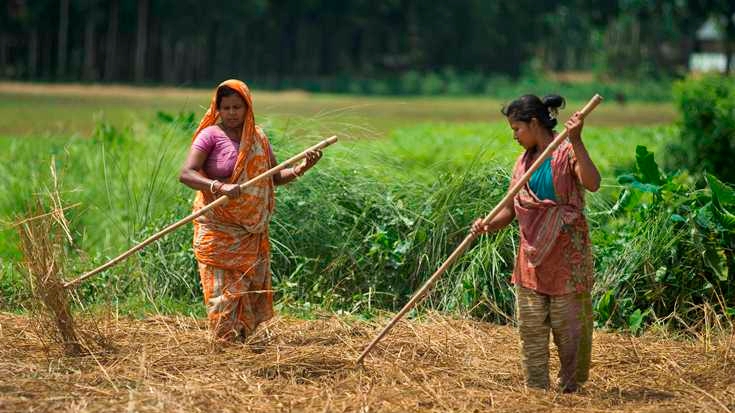Agriculture and the rural non-farm economy, which together contribute 56% of the gross domestic product, are the main sources of livelihood for rural people. Raising agricultural productivity and improving the economy of the rural non-farm sectors is crucial to ensure food security, generate employment and reduce poverty in rural Bangladesh. The National Agricultural Technology Project (NATP) aims to improve effectiveness of the technology used in agriculture to increase productivity and farm income, with a particular focus on small and marginal farms.
Challenge
Agriculture in Bangladesh is characterized by small, rice-dominated farms, which have greatly contributed to increasing food self-sufficiency over the last 30 years. However, this self-sufficiency is continuously threatened by an increasing population and stagnating yields. At the heart of the problem is the “yield gap,” the difference between the amounts produced and the potential for production, which remains large as farmers fail to maximize the use of land. Weak technology carries much of the blame. Farmers lack the machinery and information systems to store their products postharvest or to process them into high value commodities such as fruit juice and jam. Lack of crop diversification, deteriorating and declining cultivable land as well as poor linkages to markets also play a crucial part. As a result, a lot of sale potential is lost.
Approach
NATP is a home-grown initiative designed to tackle the modern challenges of agriculture and help farmers in Bangladesh bridge the yield gap. Firstly, the project has established an autonomous Agriculture Research foundation – known as the Krishi Gobeshana Foundation (KGF) - that has objectively and transparently financed applied agricultural research projects. These research projects have achieved a number of significant outcomes such as the development of genotypes of spices, rice and tomato that were released by the National Seed Board. Research activities have focused on promoting climate-smart agriculture and subprojects covered agro-ecologically constrained ecosystems including Saline intrusion, Hill terrain, Haor, Char land, and Drought and Floodplains areas.
Secondly, farmers have been mobilized into Common Interest Groups that can access relevant research and technologies to improve the agricultural productivity. Farmers have adopted new technologies and the project has also demonstrated 34 new supply chain technologies to improve linkages to markets, which have been adopted by over 8,000 farmers.
Thirdly, the project has set up 25 Commodity Collection and Marketing Centers to act as commercial forums for farmers and local stakeholders and help in negotiating better prices for their products. Since inception, 21,500 tons of fresh produce from small and marginal farmers has been sold through these centers, adding a net benefit of Taka 68 million as compared to sales from traditional markets.
Finally, to facilitate production of the variety and the quality of commodities demanded by the market, the project helps producers organize themselves into groups and diversify production by self-selecting market options and products they wish to invest in. This helps to integrate small and marginal producers into value chains covering key commodities of interest to the poor, including rice, maize, fruits, vegetables, livestock and fisheries.
Results in Numbers
- 1.31 million farmers adopted 47 demonstrated new technologies.
- 200 applied research projects funded.
- 732 Farmers Information and Advisory Center (FIAC) established and functioning.
- 400,000 farmers have been mobilized into over 20,000 Common Interest Groups linked to markets.
- Over 16,000 farmers adopted 34 improved post-harvest technologies and management practices.
- 14.1% increase in Maize production, 15.8% increase in Wheat, 16.3% increase in Mungbean, 20.5% increase in Clean Rice and 19.6% increase in Mustard.
- 26% participation of women.
- 108 scientists including females awarded scholarships to pursue high studies in agriculture.
Towards the Future
The project was restructured and received additional financing of over $23 million from the United States Agency for International Development (USAID) to support the government’s strategy to improve the national agricultural technology system. The restructured project is estimated to directly benefit about one million farmers, of which 30% of the adopters of new technology and farming practices would be women, and it is expected to foster 530,000 sustained adopters.

